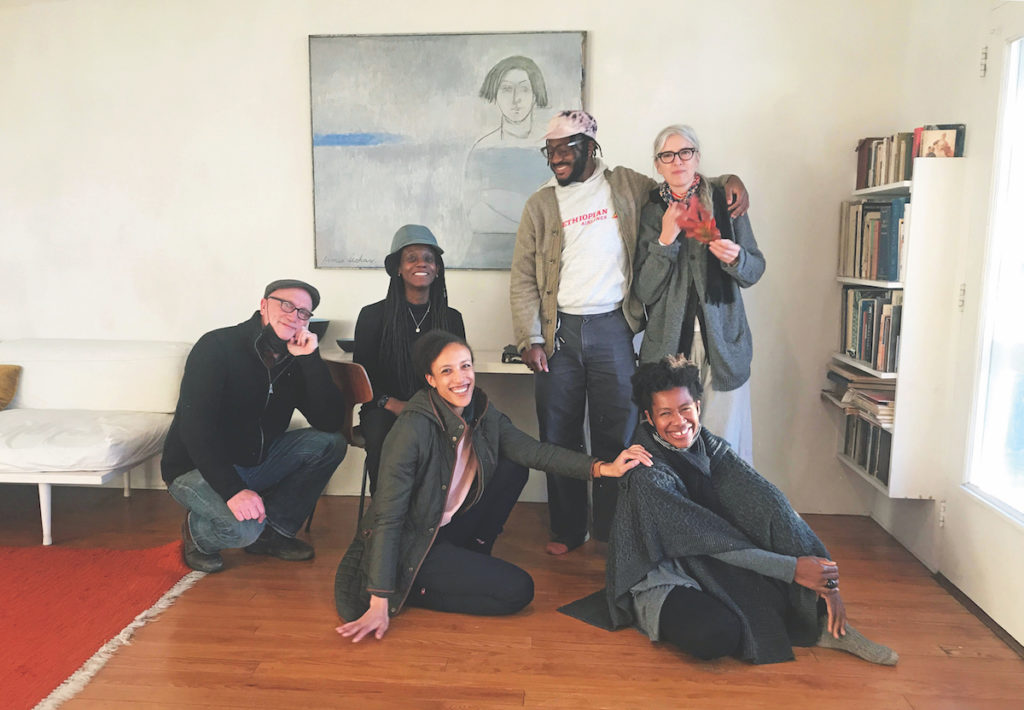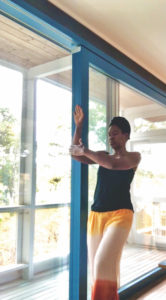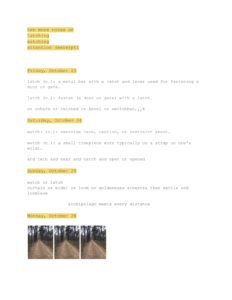
A storm rolls toward the Outer Cape, stirring the ocean’s waves and sending shivers through the pine forest. Unperturbed, a lone figure dances on the deck of the Kugel/Gips House, nestled among Wellfleet’s kettle ponds. Moving with a certain geometry in mind, Brittany Engel-Adams climbs a rail and tilts her face into the rain, mirroring the angle of the locust leaves around her as they bow with the weight of falling water.

Less than a mile away, in the living room of the Weidlinger House, movement-based performance artist, vocalist, and writer mayfield brooks playfully navigates the architectural space, eyes closed, listening to the cacophony of the natural world (brooks uses the pronouns they/them and no capital letters in their name).
“One day while I was here, a family of otters came up the little pathway to the house,” brooks says. “They were dancing, and I’m a dancer, so their movement inspired me.”
From the Lechay House, a short walk from Wellfleet’s Main Street, the visual artist Marcus Leslie Singleton explores the world of the town’s winter residents, wondering, he says in his work statement, “what their stories may be.”
Engel-Adams, brooks, Singleton, and Asiya Wadud, a poet and visual artist who was the curator of the group, are four artists of color based in Brooklyn, N.Y. They were invited by the Cape Cod Modern House Trust (CCMHT) to spend 10 days in four modern homes in Wellfleet to create art inspired by the architecture and its environment. This was CCMHT’s 2020 residency program, which took place in late October. The art the group created during their stay is documented in “Digital Guestbook: 2020,” a virtual exhibit that launches on ccmht.org on Thursday, Feb. 4.
By attending the CCMHT residency last fall, the four artists stepped into a tradition of creative discourse and collaboration that began in these very homes in the mid-20th century. Bauhaus architects Marcel Breuer and Walter Gropius, who came to the U.S. as refugees from Nazi Germany, along with like-minded Americans and other European modernists who settled stateside, designed and built the houses as summer getaways on the Outer Cape after World War II. Nestled between kettle ponds, off hidden dirt roads, they became fertile gathering spaces for architects, artists, writers, and academics — a nexus of creativity and thought.
Starting in 1961, the Cape Cod National Seashore took over much of the area where the modern houses were located. Over the years, most were left empty and untended, and they fell into disrepair. CCMHT was founded in 2007 by architect Peter McMahon to preserve these architectural landmarks. The trust now leases four modern homes from the National Seashore that it has painstakingly restored to their former glory — the Kugel/Gips House, Hatch House, Weidlinger House, and Kohlberg House — all of them in Wellfleet.

“To the Bauhaus architects, they weren’t just vacation homes — they were laboratories for their own work and for collaboration with others,” says McMahon. “We wanted to bring back that vibe instead of turning them into museums.”
The format of the residency reflects that collaborative legacy. “Every year we pick a curator, and then the curator picks three artists,” McMahon says.
Because the 2020 residency was held in October, one artist (Singleton) was put up in the Lechay House, a modern home owned by the family of painter James Lechay, instead of the CCMHT’s Hatch House, which doesn’t have heat.
As curator, Wadud wanted to keep things relevant and immediate. “I asked myself what kind of togetherness is possible in this specific pandemic moment, and how can we think of that as just as rich and potent as the togetherness of being in the same space pre-pandemic,” she says.
The nature of this residency, Wadud realized, with each artist living in a different house, lends itself to a “kind of alone together distance.” To form the group, she chose artists who fit together well. “Works by Brittany, mayfield, and Marcus speak to each other,” Wadud says, but “that doesn’t happen directly as much as it does in a sideways or oblong way. There are so many different questions that could emerge between the three of them.” She gives the example of Singleton’s painting: “I see his work as bounded in movement. It has this same aliveness as mayfield’s or Brittany’s dance movements.”
Wadud’s curatorial statement emphasizes that each of the artists she invited to the residency lets “Blackness and history haunt their work.” All three, she says, “trouble the value placed on Black life and they do so in a number of registers.”

The idea to document each year’s CCMHT residency in the form of digital guestbooks was inspired by Bauhaus founder Gropius. “He had a guest book in each house he lived in,” says McMahon. “They had these amazing entries from Picasso, Miró, Igor Stravinsky. In that same way, we ask our artists to leave a clue about what they were up to while they were staying in one of the homes.”
Wadud explored connectivity in her poetry by focusing on the word latch. “I got very interested in things that get latched together, and what possibilities could exist if you put two different things side by side that normally don’t go together,” she says.
Spending 10 days at Charles Zehnder’s Kugel/Gips House, says Engel-Adams, “was a very moving time for me. It was the first time I had been out of the city since Covid, and I’d never stayed in a home built in such a way before. I have a dance practice of mapping spaces, and I did improvisations moving inside the house and outside, trying to embrace its architectural features.”
Engel-Adams had previously explored other aspects of Bauhaus design. “I did a performance-based piece related to [painter-sculptor-choreographer] Oskar Schlemmer’s work,” she says. “So, I was already present to the possibilities of moving in relation to space, geometry, and form before the residency. But now I’ve gained a deeper connection, a deeper appreciation for architecture. I’m noticing the spaces I inhabit in a different way.”

Brooks worked on a piece, Whale Fall, that will be performed at the Abrons Arts Center in New York City this April. It explores what happens to a whale when it dies. “It’s a huge event when a whale falls to the ocean floor, because their bodies feed hundreds of other animals,” brooks says. “The idea is that when death and grief come, there is also an opportunity for nourishment and regeneration.”
Being in Wellfleet, brooks felt very connected to the ocean. “I didn’t get to see any whales, but it was a very palpable feeling knowing that these largest of mammals might be there,” the artist says. “It touched me and fed into my creative process.”
Because of the pandemic, the group was careful to meet mostly outdoors, even for dinner gatherings, despite the cold weather. “We were working independently on our projects, and then we’d come together outside to talk and reflect,” says Engel-Adams.
“There weren’t many times when we were physically in the same space at all,” Wadud says.
None of the precautions dampened the group’s sense of connection. “Simply knowing that each artist was staying in a modern house close by brought us together,” Engel-Adams says.
“The 10 days we spent on the Cape were filled with possibility,” Wadud says. “We started a collaboration at the residency that will continue, and we share a desire to be here together again.”
